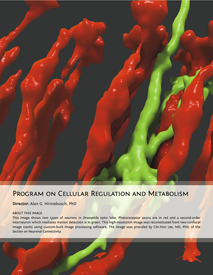You are here: Home > Program in Cellular Regulation and Metabolism
Program in Cellular Regulation and Metabolism
Director: Alan G. Hinnebusch, PhD
The seven investigators in this program, all belonging to the Laboratory of Gene Regulation and Development (LGRD), share a common interest in using genetically tractable model organisms and a combination of genetics, biochemistry, cell biology, and structural biology to elucidate the molecular basis of processes of fundamental importance in cell biology or animal development. Three groups employ yeast as a model system, with two studying molecular mechanisms of transcriptional and translational control of gene expression in budding yeast, and a third studying transposition of mobile elements in fission yeast. Two groups employ the fruit fly Drosophila to investigate development and function of neural circuits, including synaptic specificity in the visual system and assembly and growth of synapses at the neuromuscular junction. The anuran Xenopus laevis serves as a model system for the work of the remaining two groups, one focusing on spindle assembly and chromosome segregation and the roles of covalent protein modification by SUMO in regulating these events, and the other on transcriptional programming during the postembryonic formation of adult stem cells.
Members of the Section on Nutrient Control of Gene Expression, headed by Alan Hinnebusch, study mechanisms of transcriptional and translational gene regulation in budding yeast. Recently, they provided evidence that ribosomal contacts of the translation initiation factor 1 (eIF1) are crucial for the accuracy of start codon selection and they identified a novel interaction between eIF1A and eIF5 required for completion of GTP hydrolysis by eIF2 upon start codon recognition. They also uncovered a new function of eIF4B in promoting assembly of the cap-binding complex eIF4F and identified domains in eIF4B critical for mRNA attachment to the preinitiation complex and efficient translation initiation in vivo.
The Section on Cell Cycle Regulation, headed by Mary Dasso, studies mechanisms that assure accurate chromosome segregation in metazoan cells. The group focuses on the role of proteins involved in nuclear trafficking during interphase, nuclear pore complex proteins, and Ran GTPase pathway components, which have been shown to have essential roles in mitosis. The group's recent work reveals new regulatory mechanisms for these pathways that play a pivotal role in mitotic control.
The Section on Protein Biosynthesis, headed by Thomas Dever, is characterizing the structure and function of translation initiation factors and stress-responsive eIF2a kinases, as well as viral regulators of these kinases, that control cellular protein synthesis. The group recently demonstrated that the hypusine-containing protein eIF5A promotes translation elongation by stimulating the peptidyl transferase activity of the ribosome and facilitating the reactivity of poor substrates like proline. They also characterized a human X-linked intellectual disability syndrome caused by a mutation in eIF2g that impairs eIF2b binding, thus providing a molecular basis for the human disease, and they identified eIF2 contacts with the ribosome.
Henry Levin heads the Section on Eukaryotic Transposable Elements, which analyzes long-terminal repeat (LTR) retrotransposons and the integration of their cDNA into the chromosomes of host cells. Recently, the laboratory adapted methods of deep sequencing to determine the positions of retrotransposon Tf1 integration throughout the genome of Schizosaccharomyces pombe. Their new methods are capable of measuring levels of integration at individual nucleotides and have provided a reproducible and saturating profile of integration throughout the genome of S. pombe. In other studies, the laboratory adapted the Hermes transposon from the housefly to generate maps, of unprecedented density, of integration in S. pombe. The profiles identify a comprehensive set of essential genes, but it is notable that nonessential genes important for robust cell growth are also identified by their intermediate levels of insertion. Similar maps of Hermes integration have now identified genes that play a role in heterochromatin formation.
The Section on Neuronal Connectivity, headed by Chi-Hon Lee, investigates the assembly and function of chromatic circuits in Drosophila. Lee's group uses high-resolution imaging and genetic approaches to determine the molecular mechanisms of dendrite development. The group revealed that photoreceptor-derived Activin restricts the dendritic field of first-order interneurons and consequentially controls their synaptic specificity. For studying visual functions, the group recently identified a hard-wired glutamatergic circuit that pools multiple UV signals to a higher visual center to mediate spectral preference behavior.
The Unit on Cellular Communication, headed by Mihaela Serpe, investigates molecular mechanisms that regulate cellular signaling during development, employing the Drosophila system. The group recently identified a highly conserved protein, Neto, required for assembly and function of glutamatergic synapses at the fly neuromuscular junction. The studies demonstrated that Neto functions as a non-channel subunit of glutamate receptor complexes and controls the recruitment and stable incorporation of receptors at postsynaptic densities. In conjunction with selective glutamate receptor subtypes, Neto also regulates local signaling by the growth factor BMP and appears to communicate synapse activity status to pathways that control synaptic growth.
The Section on Molecular Morphogenesis, headed by Yun-Bo Shi, studies the gene-regulatory mechanisms controlled by thyroid hormone receptor (TR) that establish the postembryonic developmental program in vertebrates. Using the metamorphosis in Xenopus laevis and X. tropicalis as a model, the group carried out genome-wide analyses of TR targets in an effort to identify genes likely involved in adult intestinal stem cell development. Selected genes are being characterized with regard to their roles in adult stem cells during both amphibian metamorphosis and postembryonic development in mouse.


